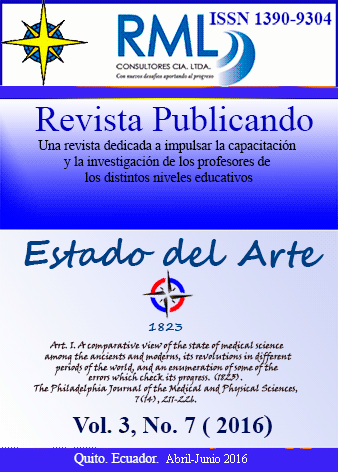Abstract
Ecuador has one of the largest and most important nature reserves in the world and international communities; the Yasuni reserve comprising 982,000 hectares of tropical rainforest, flooded forest, marshes, rivers, lakes, so it is important to preserve this ecosystem because it contains the greatest genetic diversity in the world, also it contains a variety of species, making it superior to any other ecosystem.
In 2007, the Ecuadorian government presented the Yasuní ITT initiative in the debate of the United Nations, in which it was proposed to leave 850 million barrels of oil under the ground Ishpingo Tambococha Tiputini block. This activity meant an economic loss to the country of approximately 7,000 million dollars, so the government to the international community demand a compensation of 3,500 million dollars for not emit into the atmosphere more than 400 million carbon mass for the benefits it generates the entire planet.
According to research can show that if there are natural resources and materials needed for this activity, in an operation organized by the Tourist and organizations in charge as the Ministry of Tourism. In this region it has transportation, lodging, restaurants; certificates tours MINTUR, which allows a tour of the site in a responsible and safe for tourists and inhabitants of the Yasuni National Park, respecting the ecosystem and culture the villagers.
That is why the importance of studying the model of sustainable development is in tourism in the Yasuni National Park as a possible strategy for non-oil dependence in the economic development of the country, which will take place by searching existing information on the subject.
References
Azevedo Luíndia, L. (2007). Ecoturismo indígena. Abya-Yala.
Ballesteros, E. R., & Carrión, D. S. (2007). Turismo comunitario en Ecuador: desarrollo y sostenibilidad social. Editorial Abya Yala.
Carrión, Alberto. (2009). “Esto puede ser más beneficioso que el petróleo”; Entrevista con el representante del Presidente de la República para la promoción y difusión internacional de la iniciativa – ITT; Revista Terra incógnita; N.62, Noviembre 2009.
Cisneros, P. (2009). Gobernanza ambiental y conservación de la naturaleza, un caso de control territorial indígena en el Parque Nacional Yasuní.
Diario Centinela. (2012). Reserva de Biosfera Podocarpus- El Cóndor, recuperado el 18 de septiembre de 2015, disponible en: http://diariocentinela.com.ec/2012/09/22/reserva-de-biosfera-podocarpus-el-condor/
De la UNESCO, I. M. (2005). Hacia las sociedades del conocimiento. Publicaciones Unesco. París.
Dillon, J. F. (2012). YASUNÍ-ITT: Hacia un nuevo modelo de conservación y desarrollo sostenible.
Ecuador, M. D. (2013). Ministerio de Turismo Ecuador.
Ecuale. (2015). Islas Galápagos, recuperado el 18 de septiembre de 2015, disponible en: http://www.ecuale.com/galapagos/
Espore, la veau del Botanic. (2015). Las reservas naturales más grandes del mundo, recuperado el 18 de septiembre de 2015, disponible en: http://www.espores.org/es/?option=com_k2&view=item&id=208:les-reserves-naturals-m%C3%A9s-grans-del-m%C3%B3n&Itemid=4&lang=es
Fennel, D. (2003). Ecotourism. Abingdon New York.
Fernández, A. (2013). Las zonas Naturales protegidas más necesarias del Mundo, recuperado el 18 de septiembre de 2015, disponible en http://www.consumer.es/web/es/medio_ambiente/naturaleza/2013/12/09/218817.php
INEFAN – GEF. (1998). Plan de Manejo del Parque Nacional Yasuní, Noviembre 1998.
Karas L., Ferencova M. (2012). “The survey of attitudes of students of management toeard travel tour pieces”, Polish Journal of Management Studies, Czestochowa University of Technology, Czestochowa.
La Hora Nacional. (2015). El futuro del Yasuní y de los recursos recaudados, recuperado el 18 de septiembre de 2015, disponible en: http://www.lahora.com.ec/index.php/noticias/show/1101549087/-1/El_futuro_del_Yasun%C3%AD_y_de_los_recursos_recaudados_se_conocen_hoy.html#.VfzhEt9_Oko
Llerena Guevara, R. M. (2012). Propuesta Yasuní-ITT. Una opción factible hacia el futuro sostenible del Ecuador.
Ministerio de turismo. (2015). Turismo sostenible Yasuní, recuperado el 18 de septiembre de 2015, en http://www.turismo.gob.ec/biblioteca/
Ortiz, D. (2015). Vivir en la selva gracias al turismo comunitario, recuperado el 18 de septiembre de 2015, disponible en: http://www.elcomercio.com/tendencias/napowildlifecenter-turismo-comunitario-selva-ecuador.html
Paredes Ochoa, M. A. E. (2013). Generación de Recursos Económicos Apuntalando dl Turismo como Alternativa para la no Explotación Del Yasuní Itt En El Ecuador. TURyDES,6 (15).
Phillips, A. (2002). Directrices de gestión para áreas protegidas de la categoría V de la UICN: paisajes terrestres y marinos protegidos. Comisión Mundial de Áreas Protegidas (CMAP). Serie de directrices sobre buenas prácticas en áreas protegidas, (9).
RIVAS, David M. (2004). Desarrollo sostenible y estructura económica mundial. Editorial Cideal España.
UICN. (2008). El Congreso Mundial de la Naturaleza de la UICN.
UWG, G. W., & Metis, F. Aliados de la AETS. (2009). Alianza Ecuatoriana para el Turismo Sostenible.

This work is licensed under a Creative Commons Attribution-NonCommercial-ShareAlike 4.0 International License.
Copyright (c) 2019 Cristina Chauca Pozo, Ronald Soto Aguirre, Rodrigo López Sánchez
